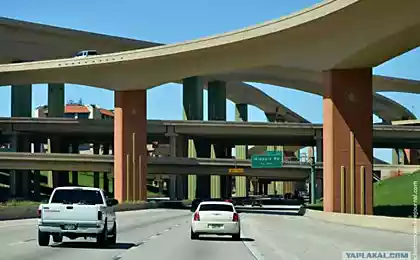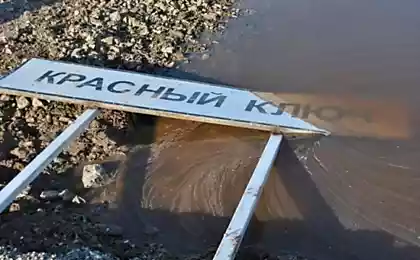837
Winter road kill Western
Still, our roads are so bad because of the harsh climate. Small period similar weather to the west is clearly proved.
In Western Europe and the United States for hundreds of years used to drive fast on good roads, long retains its original appearance. In the winter tires in many countries generally need not. On the other hand, on the Russian roads who just does not mocked. However, it emerged in the last few years the global climate variability makes to look at the situation quite differently. As this winter in Europe and the United States hit by frost snowfall, roads are not worse than we showered. In addition, the majority of Europeans and Americans absolutely no ability to ride on rough roads, ice and snow.
5 photos.

US
Massive snowfalls and poor performance of emergency services turned expensive Big Apple in uneven blurry mess of sand, asphalt, soil, snow, ice and water. This year alone, the Department of Transportation (DOT) «patched» 84 thousand. Potholes 5 urban areas. This is an absolute record in the history of conducting road repairs in New York.
The most damaged track was highway FDR Drive in Manhattan. Popular road had cut off nearly a day to fill the hole and the liquid asphalt cement. However, a few hours after the repair potholes reappeared.
"Such bad roads I've ever seen in only two countries: Nicaragua and Costa Rica, - says Matthew, a resident of Manhattan. - I think that New York drivers must make a claim to the city. Tens of thousands of people now have to pay for expensive repairs due to the inconsistency of city departments. "
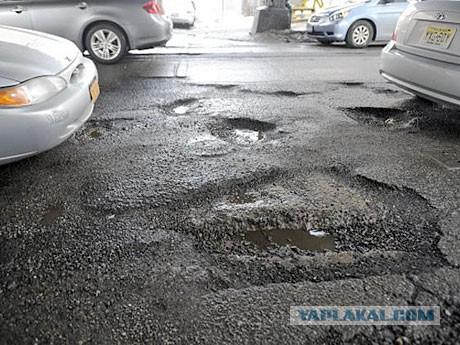
Katherine, who lives in Brooklyn, drove to a car bought on credit only 5 miles. Solid and uneven ice machine broke off two tires.
"What impressed me most is not the bad roads and the ratio of police to drivers, - complains girl. - I'm waiting for help almost 7 hours. As a result, police officers yelled at me better advised to learn rules of the road ».
According to the American Automobile Association (AAA), the number of complaints against police officers, paramedics and road repairmen in New York jumped by 30%. Many people unite in groups to judge the city for the slowness, negligence and indifference.
It is worth noting the fact that the bad roads, private companies stepped up the evacuation vehicles. Should the driver threw the car with a broken wheel or other defect on the street as it was immediately transported to the penalty parking.
"I have the impression that New York drivers were victims of a conspiracy - angry Paul, a resident of Staten Island. - Two of my front wheel got into a deep pit and a half feet. It happened at a speed of 35 miles per hour. I drove the car to the side of the road with the help of passers-by, went to the nearest store to buy a coffee, and when I came back - the car was no longer there ».
An employee at the tow truck was acting so rude and irresponsible that one of the wheels came off the car of Paul on the road to cross the parking lot. Similar stories in New York City rife. Social networks like Facebook photos abound, supporting traffic chaos in the Big Apple.
New New York Mayor Bill De Blasi, who criticized his predecessor Bloomberg poorly cleared road, was powerless before snowfall. Scavengers and nurses can not cope with their duties for more than two weeks. Some roads are not cleared away for 18 - 36 hours. Residents of Manhattan's elite areas of difficulty walking even on foot, as the city services are in no hurry "to work for the rich».
De Blasi, meanwhile, prefers not to talk about traffic problems. It creates the appearance that the city's infrastructure is in good order.
Interestingly, the 911 service in New York City and the surrounding area are increasingly ignoring calls on large road potholes. Sometimes managers are advised to call the help line 311 or the Department of Transport.
Automotive experts advise New Yorkers not to drive without much need. The risk of accidents on rough roads is too large, so it is best to use public transport.
03.
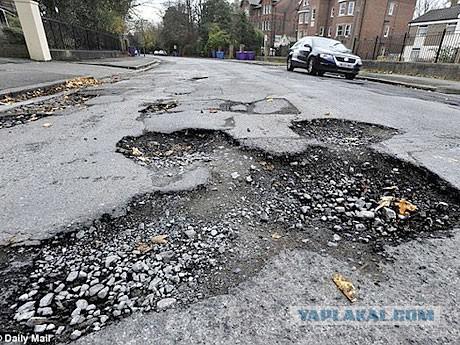
UK
The UK government has expressed concern about the country's roads. According to the publication Daily Mail, for 2013 as compensation for damage incurred due to the pits on the roads, addressed almost 40 thousand. British people, nearly one-fifth more than a year earlier.
Despite the increase in the number of complaints, the level of compensation for damaged cars, by contrast, has declined. So, in 2013, managed to sue the drivers of road services by an average of 375 pounds, while the previous year it amounted to 1 565 pounds.
According to the British authorities, the deterioration of the quality of the road surface is directly related to more severe winters, as well as the reduction of road funding. For example, the municipalities complain that the lack of direct cash infusions from the center leads to the fact that they have to be limited to the local "patching».
The UK government believes that to bring the roads in good condition can take up to 140 million. Pounds, while "on the ground" is considered the amount "insufficient" and talk about the underfunding of 10, 5 billion. Lbs.
GERMANY
Such roads Germany has never known! Potholes, ruts, cracks, broken asphalt ... To fill holes, which left on German roads this winter, will require at least 3 bln. Euro.
Schlagloch - remember that word! It can be a "word of the year" in Germany. That's what the Germans call the potholes on the roads. Now it sounds very often, even where the road surface any problems so far did not know. After this winter all drivers - and residents and tourists, and those who transit passes Germany - must be prepared for unpleasant surprises. In one only the Hanseatic city of Lübeck counted 14 thousand. Potholes! Experts Society for Technical control and supervision of TÜV Rheinland suggest that Germany is now damaged by 30 - 40% of the pavement.
Siberian frost
The winter was unusually long, snowy and cold. Such cold weather forecasts that television commentators called the Siberian frost, and even added that they (frost) tie Germany: Sibirische Kälte hat Deutschland fest im Griff ...
It should be noted that the Germans call the Siberian frost when the temperature reaches about minus 15 or minus 10 degrees. For Germany (except perhaps the Alpine foothills of Bavaria) unusually cold. And that was enough to make the streets of German cities, new holes, cracks and potholes. Moreover, in such quantities that their repair, even cosmetic, can supply many local budgets to the brink of bankruptcy if they do still have "free" money.
The long and cold winter for roads was a catastrophic disaster, the mechanism is very simple: water freezing in cracks, the ice broke the cover, and heavy traffic is doing its job ...
04
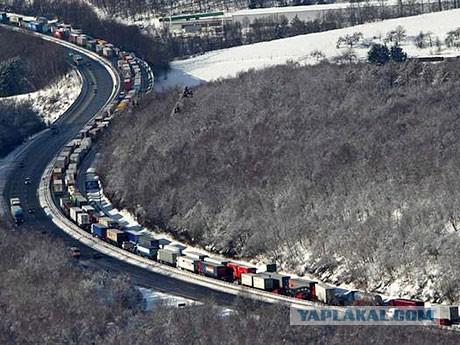
64 THOUSAND. KM - The REPAIR
According to the estimates of experts-German Automobile Club (ADAC), only to repair roads and streets under the jurisdiction of the local authorities, that is, cities and rural communities, will require an additional 3 billion. Euros! Closer to spring, when the full impact will become apparent, the amount has increased, experts predict.
At the same time last year for the construction and maintenance of urban and local communal roads in Germany it was spent 5 billion. EUR 8 billion with the necessary. This chronic underfunding is one of the reasons why the Siberian frosts so hurt the German asphalt. Where thinly, there and tear.
Note that while it was only on local roads. But in the winter at least suffering highways (Autobahn) and federal highways (Bundesstraßen), under the responsibility of the federal government. Additional costs are expected budgets and land. Of these, financed the construction and maintenance of highways land (Landesstraßen). They should not be confused with Landstraßen. So-called ordinary roads between settlements, regardless of funding and accountability, as well as country roads.
According to the Automobile Club ACE (Auto Club Europa), the total length of municipal and local roads municipal reference in Germany is 400 thousand. Km. Of these, until recently, without taking into account the effects of this record-breaking winter repairs needed 64 thousand. Kilometers. The club even posted on its website a special form, that can be used to inform the authorities about potholes and other damage.
Of course, when it comes to injuries, it does not mean that the German track was because of them impassable. Statistics records, for example, and cracked. But in some cases the authorities had to resort to emergency measures. In early February, for emergency repairs for about half closed to traffic a 13-kilometer stretch of the federal highway A1.
The event is so rare that it was informed of all the news channels. Shortly before that, more than a day has been closed another highway, but for another reason: in the division on its service over road salt. As a result, the resulting ice for an hour or two in a small area there were more than a dozen accidents. The fast lane was closed and allowed to bypass traffic on a "slow" roads.
February 22, the Federal Ministry of Transport reported that the German Government the opportunity to check the allocation of additional funds for the repair of federal roads.
Some urban municipalities that do not keep patching up holes road already closed for the movement of whole streets. More often - put speed limit signs of 30 km per hour, so that at least in such a way to ensure the safety and fence themselves from lawsuits car owners who have received damage if it enters the pits and potholes.
On some motorways, speed is limited to 80 km per hour. In turn, the experts of automobile clubs point out that such measures do not fix the situation, and calling for an overhaul.
But the potholes on the roads and the need to repair them - not only the financial implications of the Siberian winter in Germany. Throughout almost doubled the cost of cleaning the streets from snow and flouring them with salt. For example, in Hamburg - 6, 9 million. Euros to more than 10 million. Euros per season.
Furthermore, increased costs insurance companies. For three months, starting in December, the number of accidents by as much as 55 thousand. Exceeded last year's figure. It is estimated that the additional costs of insurers will be about 230 million. Euro.
Source
05. on the list do not have any photos of Russia and CIS countries
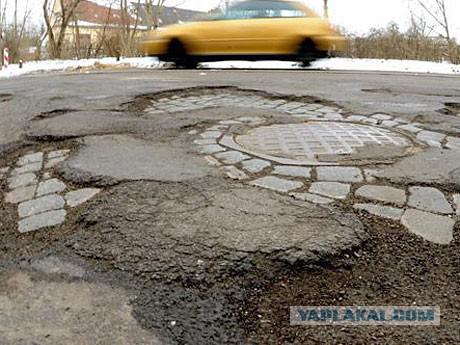
Source:
In Western Europe and the United States for hundreds of years used to drive fast on good roads, long retains its original appearance. In the winter tires in many countries generally need not. On the other hand, on the Russian roads who just does not mocked. However, it emerged in the last few years the global climate variability makes to look at the situation quite differently. As this winter in Europe and the United States hit by frost snowfall, roads are not worse than we showered. In addition, the majority of Europeans and Americans absolutely no ability to ride on rough roads, ice and snow.
5 photos.

US
Massive snowfalls and poor performance of emergency services turned expensive Big Apple in uneven blurry mess of sand, asphalt, soil, snow, ice and water. This year alone, the Department of Transportation (DOT) «patched» 84 thousand. Potholes 5 urban areas. This is an absolute record in the history of conducting road repairs in New York.
The most damaged track was highway FDR Drive in Manhattan. Popular road had cut off nearly a day to fill the hole and the liquid asphalt cement. However, a few hours after the repair potholes reappeared.
"Such bad roads I've ever seen in only two countries: Nicaragua and Costa Rica, - says Matthew, a resident of Manhattan. - I think that New York drivers must make a claim to the city. Tens of thousands of people now have to pay for expensive repairs due to the inconsistency of city departments. "

Katherine, who lives in Brooklyn, drove to a car bought on credit only 5 miles. Solid and uneven ice machine broke off two tires.
"What impressed me most is not the bad roads and the ratio of police to drivers, - complains girl. - I'm waiting for help almost 7 hours. As a result, police officers yelled at me better advised to learn rules of the road ».
According to the American Automobile Association (AAA), the number of complaints against police officers, paramedics and road repairmen in New York jumped by 30%. Many people unite in groups to judge the city for the slowness, negligence and indifference.
It is worth noting the fact that the bad roads, private companies stepped up the evacuation vehicles. Should the driver threw the car with a broken wheel or other defect on the street as it was immediately transported to the penalty parking.
"I have the impression that New York drivers were victims of a conspiracy - angry Paul, a resident of Staten Island. - Two of my front wheel got into a deep pit and a half feet. It happened at a speed of 35 miles per hour. I drove the car to the side of the road with the help of passers-by, went to the nearest store to buy a coffee, and when I came back - the car was no longer there ».
An employee at the tow truck was acting so rude and irresponsible that one of the wheels came off the car of Paul on the road to cross the parking lot. Similar stories in New York City rife. Social networks like Facebook photos abound, supporting traffic chaos in the Big Apple.
New New York Mayor Bill De Blasi, who criticized his predecessor Bloomberg poorly cleared road, was powerless before snowfall. Scavengers and nurses can not cope with their duties for more than two weeks. Some roads are not cleared away for 18 - 36 hours. Residents of Manhattan's elite areas of difficulty walking even on foot, as the city services are in no hurry "to work for the rich».
De Blasi, meanwhile, prefers not to talk about traffic problems. It creates the appearance that the city's infrastructure is in good order.
Interestingly, the 911 service in New York City and the surrounding area are increasingly ignoring calls on large road potholes. Sometimes managers are advised to call the help line 311 or the Department of Transport.
Automotive experts advise New Yorkers not to drive without much need. The risk of accidents on rough roads is too large, so it is best to use public transport.
03.

UK
The UK government has expressed concern about the country's roads. According to the publication Daily Mail, for 2013 as compensation for damage incurred due to the pits on the roads, addressed almost 40 thousand. British people, nearly one-fifth more than a year earlier.
Despite the increase in the number of complaints, the level of compensation for damaged cars, by contrast, has declined. So, in 2013, managed to sue the drivers of road services by an average of 375 pounds, while the previous year it amounted to 1 565 pounds.
According to the British authorities, the deterioration of the quality of the road surface is directly related to more severe winters, as well as the reduction of road funding. For example, the municipalities complain that the lack of direct cash infusions from the center leads to the fact that they have to be limited to the local "patching».
The UK government believes that to bring the roads in good condition can take up to 140 million. Pounds, while "on the ground" is considered the amount "insufficient" and talk about the underfunding of 10, 5 billion. Lbs.
GERMANY
Such roads Germany has never known! Potholes, ruts, cracks, broken asphalt ... To fill holes, which left on German roads this winter, will require at least 3 bln. Euro.
Schlagloch - remember that word! It can be a "word of the year" in Germany. That's what the Germans call the potholes on the roads. Now it sounds very often, even where the road surface any problems so far did not know. After this winter all drivers - and residents and tourists, and those who transit passes Germany - must be prepared for unpleasant surprises. In one only the Hanseatic city of Lübeck counted 14 thousand. Potholes! Experts Society for Technical control and supervision of TÜV Rheinland suggest that Germany is now damaged by 30 - 40% of the pavement.
Siberian frost
The winter was unusually long, snowy and cold. Such cold weather forecasts that television commentators called the Siberian frost, and even added that they (frost) tie Germany: Sibirische Kälte hat Deutschland fest im Griff ...
It should be noted that the Germans call the Siberian frost when the temperature reaches about minus 15 or minus 10 degrees. For Germany (except perhaps the Alpine foothills of Bavaria) unusually cold. And that was enough to make the streets of German cities, new holes, cracks and potholes. Moreover, in such quantities that their repair, even cosmetic, can supply many local budgets to the brink of bankruptcy if they do still have "free" money.
The long and cold winter for roads was a catastrophic disaster, the mechanism is very simple: water freezing in cracks, the ice broke the cover, and heavy traffic is doing its job ...
04

64 THOUSAND. KM - The REPAIR
According to the estimates of experts-German Automobile Club (ADAC), only to repair roads and streets under the jurisdiction of the local authorities, that is, cities and rural communities, will require an additional 3 billion. Euros! Closer to spring, when the full impact will become apparent, the amount has increased, experts predict.
At the same time last year for the construction and maintenance of urban and local communal roads in Germany it was spent 5 billion. EUR 8 billion with the necessary. This chronic underfunding is one of the reasons why the Siberian frosts so hurt the German asphalt. Where thinly, there and tear.
Note that while it was only on local roads. But in the winter at least suffering highways (Autobahn) and federal highways (Bundesstraßen), under the responsibility of the federal government. Additional costs are expected budgets and land. Of these, financed the construction and maintenance of highways land (Landesstraßen). They should not be confused with Landstraßen. So-called ordinary roads between settlements, regardless of funding and accountability, as well as country roads.
According to the Automobile Club ACE (Auto Club Europa), the total length of municipal and local roads municipal reference in Germany is 400 thousand. Km. Of these, until recently, without taking into account the effects of this record-breaking winter repairs needed 64 thousand. Kilometers. The club even posted on its website a special form, that can be used to inform the authorities about potholes and other damage.
Of course, when it comes to injuries, it does not mean that the German track was because of them impassable. Statistics records, for example, and cracked. But in some cases the authorities had to resort to emergency measures. In early February, for emergency repairs for about half closed to traffic a 13-kilometer stretch of the federal highway A1.
The event is so rare that it was informed of all the news channels. Shortly before that, more than a day has been closed another highway, but for another reason: in the division on its service over road salt. As a result, the resulting ice for an hour or two in a small area there were more than a dozen accidents. The fast lane was closed and allowed to bypass traffic on a "slow" roads.
February 22, the Federal Ministry of Transport reported that the German Government the opportunity to check the allocation of additional funds for the repair of federal roads.
Some urban municipalities that do not keep patching up holes road already closed for the movement of whole streets. More often - put speed limit signs of 30 km per hour, so that at least in such a way to ensure the safety and fence themselves from lawsuits car owners who have received damage if it enters the pits and potholes.
On some motorways, speed is limited to 80 km per hour. In turn, the experts of automobile clubs point out that such measures do not fix the situation, and calling for an overhaul.
But the potholes on the roads and the need to repair them - not only the financial implications of the Siberian winter in Germany. Throughout almost doubled the cost of cleaning the streets from snow and flouring them with salt. For example, in Hamburg - 6, 9 million. Euros to more than 10 million. Euros per season.
Furthermore, increased costs insurance companies. For three months, starting in December, the number of accidents by as much as 55 thousand. Exceeded last year's figure. It is estimated that the additional costs of insurers will be about 230 million. Euro.
Source
05. on the list do not have any photos of Russia and CIS countries

Source:



